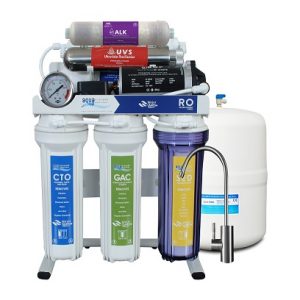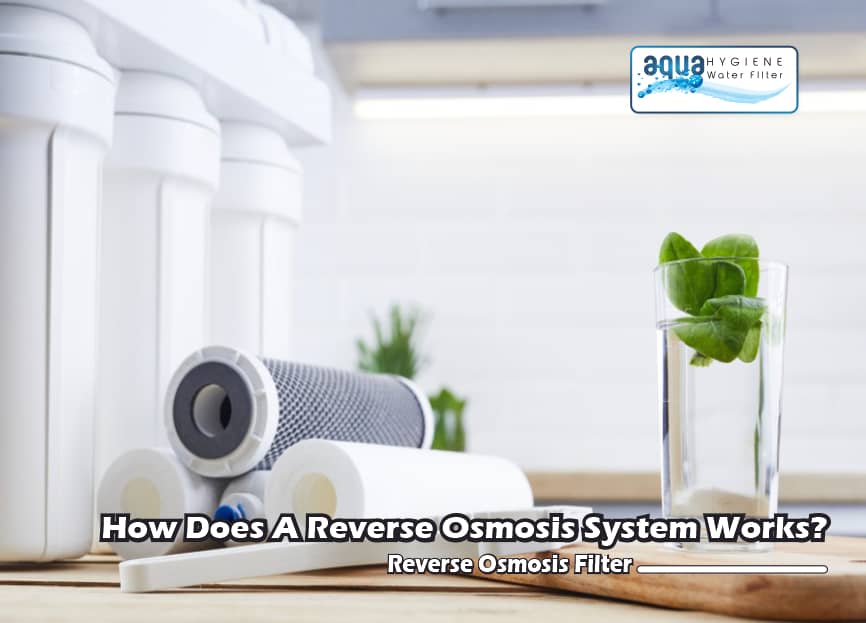Aqua Hygiene is the world’s leading manufacturer of high-quality household and commercial water solutions. We sell water purifiers both retail and wholesale. We also install water purifiers and whole house water filtration systems. We aim to provide our customers with clean drinking water and softened shower water using our top-quality customer service. Our team of committed professionals works closely during the engineering and manufacturing of technologies and products for the best outcome for our customers.
What is Reverse Osmosis?
Reverse osmosis uses a semipermeable membrane to remove contaminants from feed water. Pressure forces the feed water to flow from the side with a higher concentration of contaminants to the side with a lower concentration of contaminants through the semipermeable membrane. This semipermeable membrane also referred to as reverse osmosis (RO) membrane, is made of a thick polyimide film containing tiny pores that restrict organic compounds but allow water to pass through. The purified water is called the permeate while the water left containing the contaminants is called the waste or brine.
Parts of a Reverse Osmosis System

Aqua Hygiene Water Purifier 7 stage reverse osmosis system
Aqua Hygiene specializes in RO Systems that comply with all industry standards created to ensure the elimination of harmful particles and contaminants in the water. This makes us the preferred choice for water treatment and purification service providers. A reverse osmosis system consists of several stages of filtration made with RO membrane and other types of liquid filters. The other types of filters used in a reverse osmosis system are either prefilters or post-filters. Prefilters refer to the filters placed before the RO membrane. Post-filters refer to filters that water passes through after exiting the RO membrane, and they serve as a polishing stage. The number of the following filters used in a reverse osmosis system vary depending on the number of stages of filtration needed to achieve the desired water quality:
- Sediment Filter. Addresses the removal of particles such as dirt, dust, and rust.
- Carbon Filter. Removes volatile organic compounds (VOCs), chlorine, and particles causing bad taste and odor.
- RO membrane. Responsible for up to 98% removal of total dissolved solids (TDS).
Working Principle of a Reverse Osmosis System
An RO system removes sediments and dissolved solids such as chlorine, fluoride, arsenic, and other salts through the following steps:
- Upon the entering of feed water into the RO system, it passes through prefilters. Prefilters aim to remove large particles that could clog or damage the RO membrane. Typically, prefilters used are a combination of sediment filters and carbon filters.
- After passing through the prefilters, the water goes through the RO membrane. The RO membrane can remove the majority of the total dissolved solids or particles smaller than two microns.
- Exiting the RO membrane, the permeate or filtered water flows through the storage tank where it is contained until needed for use. The reverse osmosis system continues to operate until the storage tank is full.
- When clean water is needed and the faucet is opened, the clean water flows out of the storage tank to pass through a postfilter for polishing before going to the faucet.
A reverse osmosis system provides a reliable source of clean drinking water. As it removes sediments, 98% of dissolved solids, and bad tastes and odors, it ensures the water is safe for human consumption. Furthermore, it is easy to install and requires little maintenance. It also consumes only minimal space as it can fit under the kitchen sink.
If you are looking for water filters and purifiers, visit our website to learn more about our products and services. For any inquiries, feel free to contact us.


